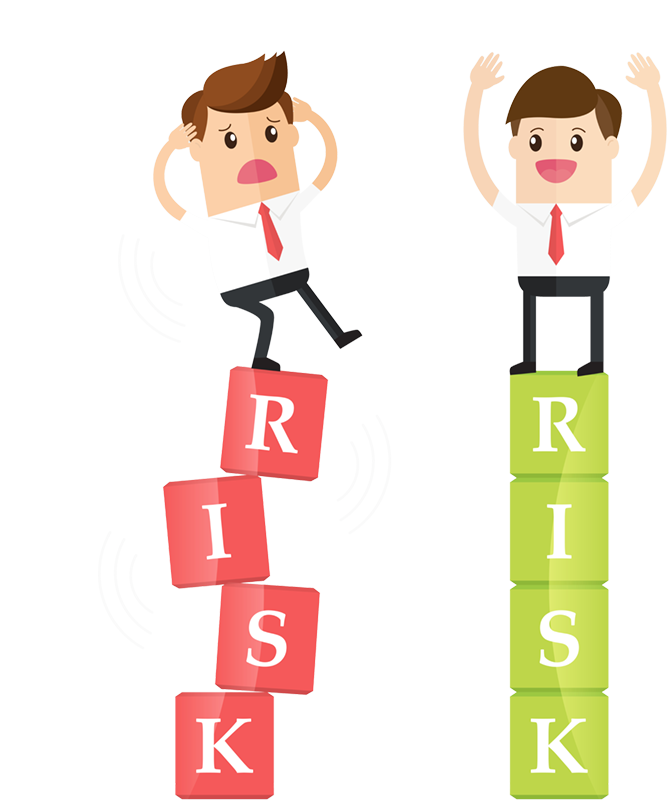Intelligent
Investment Pieces
Learn about key pieces of the investment puzzle and simplify the unnecessarily complex world of investing.
Risk and You - 5 of 6
Risk Profiling for Long-Term Investing
The Ontario Securities Commission commissioned a study called Current Practices for Risk Profiling in Canada And Review of Global Best Practices.
The document is quite complex, but it did a very good job defining how you might interact with risk. So let's review the risk profiling definitions in context of long-term investing.

Study Finding #1 - Risk Tolerance
The willingness of an individual to take on risk. It can be defined through a person’s attitude towards risk and is often described as being high or low.
Study Finding #2 - Risk Aversion
An individual’s disinclination towards or dislike of risk. A risk-averse person is unlikely to engage in any risky behaviour as it makes them uneasy. Risk aversion is the flip side of the risk tolerance coin.
Study Finding #3 - Loss Tolerance/Loss Aversion:
These terms relate to human nature. In short, a person who loses $100 will be more unhappy than another who gains $100 will be happy.
How does this impact you?
Given that you are investing for ten or more years, and if you restrict yourself to buying large, good-quality companies or ETFs, you can tell your brain that a price drop is really just volatility and not a permanent impairment in value. In other words, you can tell your brain to manage your risk tolerance while you have ten years or more to invest. By taking on and managing risk, it will enable you to capture higher returns of long-term investing in equities.

Study Finding #4 - Risk Capacity:
An individual’s ability to endure a potential financial loss. The extent to which a person has the financial ability to take on the risk.

How does this impact you?
When you begin long-term investing, you are basically saying to yourself: “The money I set aside for long-term investing is money I will not require for at least ten years.” If you fall short one month, or your roof leaks, or your car needs a repair, your Current Self must promise your Future Self that you will not touch the money you have set aside for long-term investing. Instead, your Current Self will tap into your savings account, line of credit, parents, or whomever, for a short-term loan.
Do not put yourself in a position of having to sell your long-term investments to meet a short-term obligation, as you then risk being forced to sell when the market is down!
Study Finding #5 - Risk Composure:
This is the likelihood that, in a perceived crisis, an individual will behave irrationally and may take action that could crystalize losses. This can be measured based on a person’s past decisions.
How does this impact you?
Basically you should know whether you will freak out when the going gets tough, i.e., when, not if, the market drops 20% or 50% over a one- or two-year timeframe.
In long-term investing, assuming you have the capacity to keep up your lifestyle when the market inevitably has a big drop (see Risk Capacity, above), you can tell your brain to see the drop as an opportunity to purchase equities on sale to bolster your long-term investing success, i.e., your Current Self will buy low and your Future Self will sell high!
"Stock market meltdowns are like natural disasters, unpredictable and unavoidable." ― John Heinzl, Globe & Mail
"Volatility is the price you pay for performance." ― Samantha McLemore, Legg Mason

Study Finding #6 - Risk Perception:
This perception can be heavily influenced by the media and/or a lack of understanding of the risks. The influence of risk perception and ambiguity aversion may be reduced by greater financial literacy, education and/or experience.

How does this impact you?
This is the great debate – perception versus reality! When, not if, the market has a big drop, you have to manage your emotions. The first step in being able to do this, is to educate yourself about investing, which, by the way, is exactly what you are doing now! In long-term investing, market drops can be seen as mere volatility, and therefore buying opportunities, i.e., the shoes you wanted are finally on sale!
Study Finding #7 - Risk Need:
This is the amount of risk that an individual should expect to take on in order to meet specific financial goals. Higher goals may require higher returns on investment, which come at the cost of higher risk.
How does this impact you?
This is an important concept. Basically, because of inflation, not investing is not an option. It also ties into the concept of the Rule of 72, (if you are not sure about this, see Investment Piece #1 "Mankind's Greatest Discovery"). If you have 12 years before you need to tap your investments, and you only need to double the amount of money you have one more time, then you can use a low-risk portfolio and target a return of 6% per year. However, if you need your money to double twice in 12 years, you will need to take on a lot of risk to try to earn a return of 12% per year.
The lesson here is to identify how much risk you need to take on to achieve your goals. If you are close to achieving your investment objectives, then it’s time to begin to increase your allocation of fixed income securities. Also, if you have gratitude for what you have today, you will be less inclined to take on excessive risk in a quest for greater, perhaps unrealistic riches, in the future.

Study Finding #8 - Risk Preference:
An individual uses a combination of subjective and objective cognitive evaluations to generate their risk preference. There may not always be justification for the individual’s feelings regarding their preferences.
How does this impact you?
You know that due to inflation, not investing is not an option. You know that if you stop working for whatever reason, you will need more money than you have now. You know you need to get your money to grow to meet your investment objectives. Soooooo, you know that some risk is unavoidable.
The amount of risk and return you need to take on should be calculated (the Rule of 72 helps here). Generally if you need higher returns to meet your objectives, you will need to take on more risk, i.e., more equities.
Both the target return and the required risk you take on should become your risk preference. But sticking to your plan means you will need to use your brain and investing education to overcome your emotions. That means resisting the urge to sell when the market drops (due to fear), and resisting the urge buy more of a stock that is rising quickly (due to greed). This discipline is hard work, but will lead to your long-term investing success.

Study Finding #9 - Risk Profile:
The aggregate of all of these factors is used to arrive at an overall determination of an individual’s sweet spot, such that it maximizes their ability to achieve their goals but is consistent with the level of risk they are willing and can afford to take.

How does this impact you?
Hopefully, TheAnswerIs helps you think about investment risks and how you will manage your interaction with risk in a way that enables you to set your required returns, assuming only the amount of risk you need to achieve your investing objectives, but most importantly, enables you to stick with your plan!

